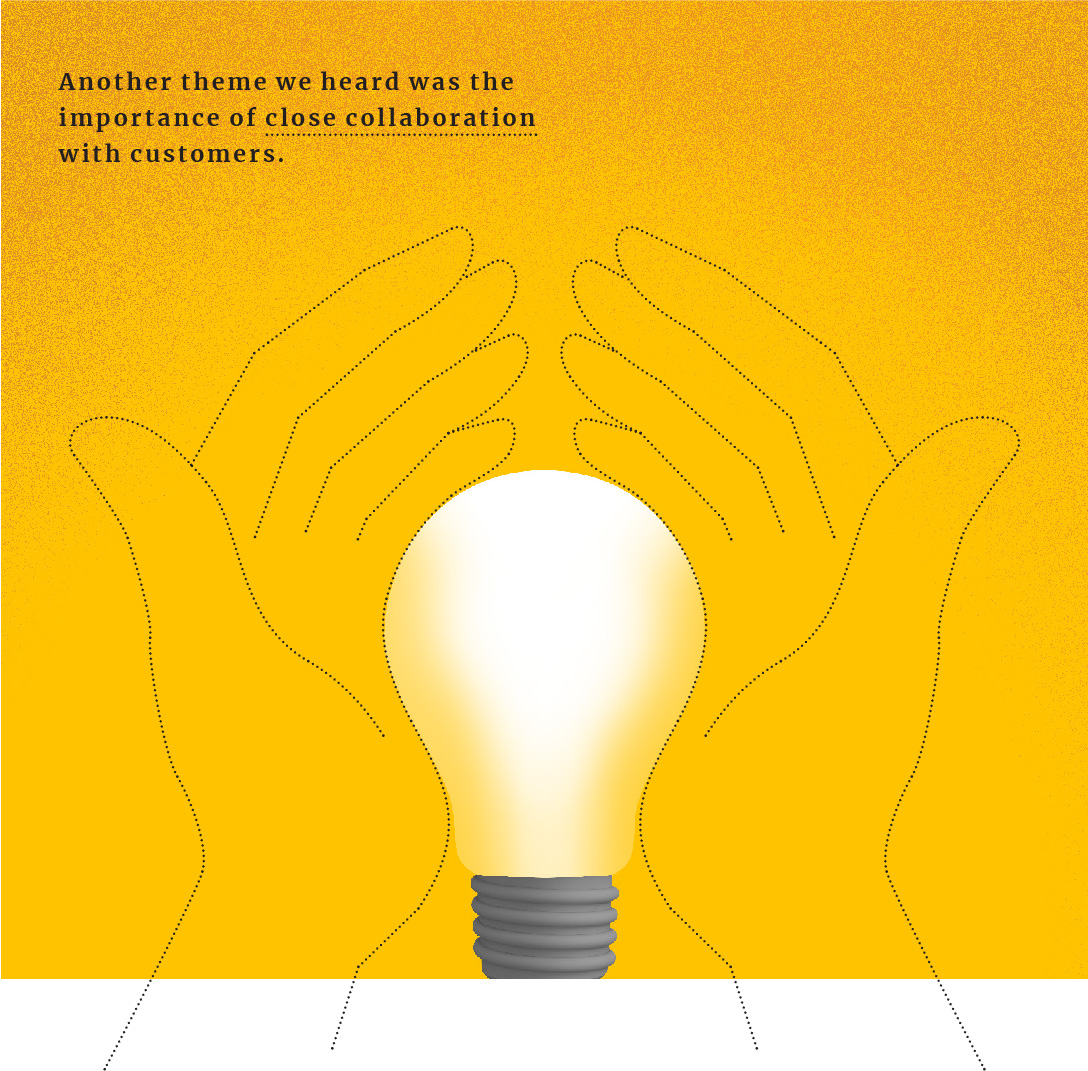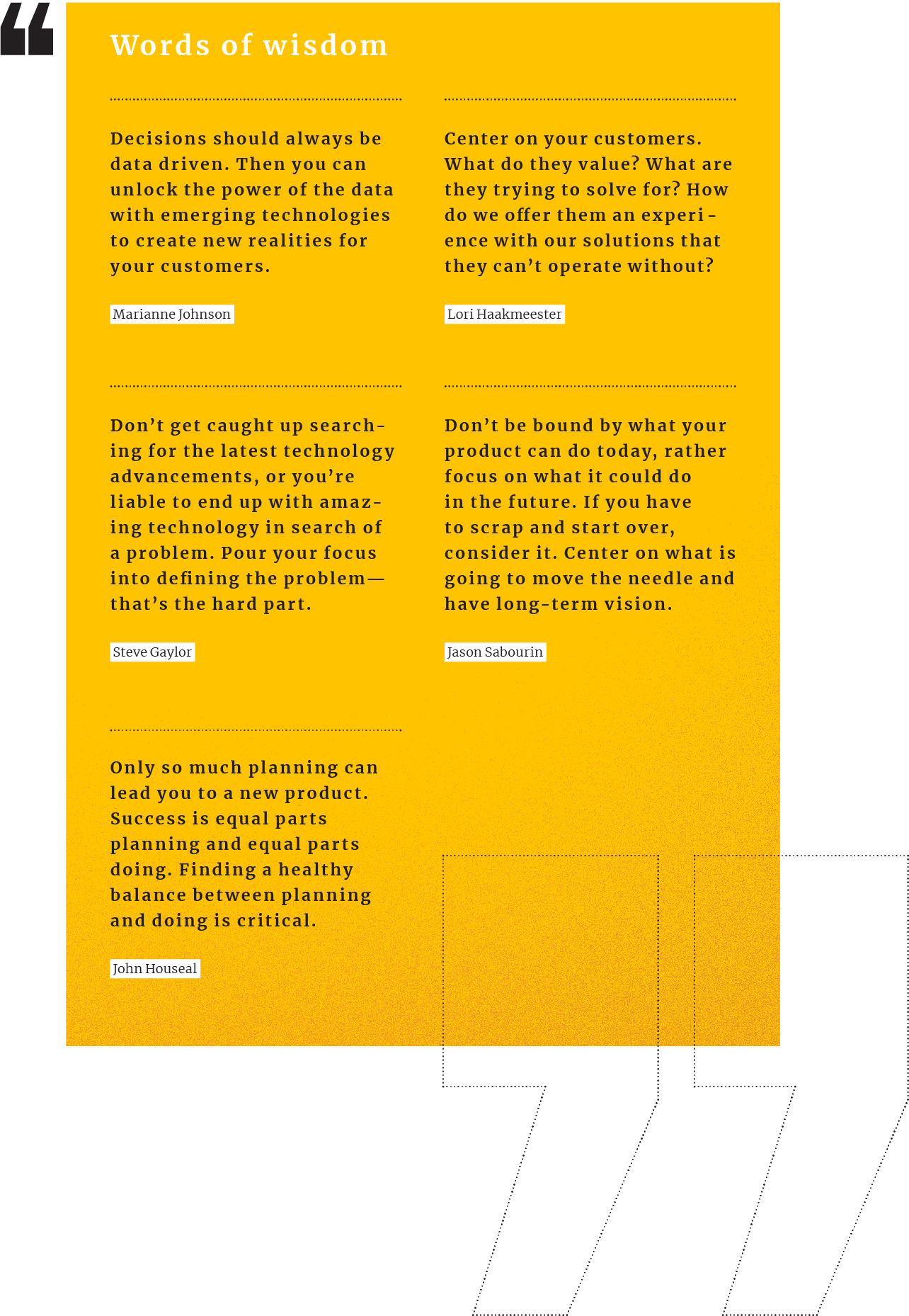Looking to build a culture of product innovation? Or are you considering launching a new product? Do you face pressure to deliver better and faster while keeping an eye on what you spend?
We get it. Innovation is hard. Launching new products and expanding capabilities is hard. It’s compounded by the pace of emerging technologies, coupled with the unrelenting expectation to deliver new products that hit the mark with your customers while “transforming” the marketplace.
We had some thoughts on what product management teams should consider, but we needed to validate them. So, we spoke with the experts: product executives, an award-winning product manager, and an elite instructor with the world-renowned Pragmatic Institute.
When we sat down with these experts, we learned even more. We heard tips, tricks, success stories, and even some of the lessons they’ve learned. Ultimately, we learned what product teams must get right to ensure that products are successful. We boiled down their recommendations into three focus areas:
- New product innovation
- Customer-centric culture
- Nailing the basics
Let’s see what our experts are doing within their own organizations—from product innovation
to launch.

Marianne Johnson
Chief Product Officer, Cox Automotive

Lori Haakmeester
Vice President, New Product Innovation & Product Operations, Cox Automotive

John Houseal
Vice President, Product Management, InComm

Jason Sabourin
Product Manager, OneTrust

Steve Gaylor
Instructor, Pragmatic Institute
New Product Innovation
First, we asked our experts how they tackle innovation. Below are the takeaways to help drive innovation into your next new product.
Understanding the market
Before introducing a new product, our experts stressed the importance of really knowing the ins and outs of the marketplace. Launching a product in an established market versus a newly identified market calls for an entirely different game plan. The maturity of the market should greatly influence your development approach.
Strategies for more established markets consist of honing and exploiting your unique value proposition. For new markets, seek a niche no one else is serving, but be prepared to quickly release enhanced offerings soon after an initial launch. Paying close attention to external factors such as regulation is also important, as they often create market opportunities.
We also heard that observing the market is not enough. Instead, really interact with your current market and the markets you’re considering entering. Talk to as many players as possible—potential customers, competitors, or partners.
John Houseal shared a marketplace interaction story from InComm that allowed his team to discover that a previously identified partner could, in fact, be a competitor, which drove a different approach. Through your interactions, be open to opportunities for new concepts or improvements to existing products. Really understanding the incentive structure is also powerful because it allows you tap into motivations.
Finding the right opportunities
Product teams should be identifying and pursuing the right opportunities to ensure that they are building the right products above all else. Our experts shared how critical it is to be laser-focused on making sure your product is solving the right problem.
A pattern many of our experts followed for identifying the right opportunities was to adopt a discover, test, and learn approach. Start with a hypothesis around a potential need. Test that hypothesis with the goal of getting data-driven feedback as quickly as possible. Houseal advises being open to learning as you go. You may begin down a path with a product concept that is completely different by the time you launch. Stumbling into a product idea is OK if the market is driving the change.
“It’s all too easy to end up with great technology in search of a problem,” Steve Gaylor told us. “The Pragmatic Institute teaches that proper market research helps in two ways. First, we discover, or learn, something we didn’t know. Second, we validate our idea to prove or disprove what we think we learned.”
Validating your hypothesis
Our experts offered several tactics for validating your product ideas. Across the board, they cautioned us to be realistic about how long that validation can take. One consideration: know the window of opportunity within your marketplace. Shorter market windows demand a “fail-fast” approach, where validation takes only months.
Rapid prototyping and iterative development are critical for validating an initial hypothesis and product enhancements. But a “fail-fast” approach may be impossible when longer market windows exist that require more time to validate your product hypothesis.
Another theme we heard was the importance of close collaboration with customers.
“Don’t be afraid of working hand in hand with your customers,” Jason Sabourin shared. “All too often, there is fear of getting it right before showing it to them.”
It’s becoming common practice for companies to collaborate with their customers through customer immersion programs, customer advisory boards, focus groups, and surveys. Your sales team’s coveted relationship with your customers also makes it important to partner closely with those teams.
While focus groups are helpful, our panel offered some cautionary words.
“Focus groups are a good tool, but also dangerous because people will express interest as long as they don’t have to part with their money,” Houseal said. “Focus groups are better served for product positioning in the market versus a measure of value.”
One additional caution: realize that the marketplace is bigger than your customer base. It’s critical to cast a wider net for validation. Gaylor recommends a survey approach.
“A good survey should be sent to a strong demographic representation of the market you think has the problems, beyond the customers you have the phone number for,” he said.
When validating your product concept, you’ll also want to quantify revenue potential. As you likely know, this can be one of the more challenging parts of validation. Avoid MSU.
“MSU stands for Making Stuff Up,” Gaylor said. “All too often, when product managers are doing revenue calculations, they can end up with a bunch of MSU.”
He added that the Pragmatic Framework reveals the two primary variables in revenue validation. First, know how pervasive the market problem is, which a market survey can help reveal. Second, know the impact of solving the customer’s problem. Understanding the impact of the problem leads us to an understanding of a customer’s willingness to pay for a product that solves the market problem.

Customer-centric culture
From innovation, we segued into discussions around a customer-centric culture.
“We live in an on-demand economy where digital solutions and personalization are leading the way,” said Marianne Johnson, chief product officer for Cox Automotive.
It’s critical now, more than ever, for companies to maintain focus on product innovation to keep pace with evolving customer expectations for buying and consuming products and services. Learning what the market problems are is foundational.
Then, product teams should be charged with understanding how these problems affect their customers and prospective customers. It’s also important to recognize that a survey may not always provide a clear answer. So, how do you create a culture that values innovation?
Collaboration is key
If you’re a Stephen Covey fan, you’re familiar with Habit No. 5, “Seek first to understand, then to be understood.” This is exactly what Johnson is accomplishing with the advent of Cox Automotive’s client immersion programs.
We learned that Cox Automotive has a high demand from clients to collaborate and innovate together. Cox Automotive took this interest in collaboration one step further by introducing opportunities for listening and learning. For two days, cross-functional teams of 10 people from product, engineering, and user experience get out of the office and sit shoulder to shoulder with a client.
These visits enable the teams to better understand their clients in ways they couldn’t before, learning how they operate and what motivates them. In fact, Cox has committed to allocating a set number of hours for their teams to spend in the field listening and learning. Having the customer’s perspective in mind gives the entire team a level of focus that didn’t exist before.
We discussed how this is a perfect demonstration of living out Pragmatic’s NIHITO® concept: “Nothing Important Happens in the Office.”
Another way to collaborate with your customers is by introducing a customer advisory board. That’s what Jason Sabourin and the OneTrust product team do to collaborate with their customers. Once a month, they facilitate customer advisory board meetings to capture detailed customer feedback, prioritize rapid development efforts, correct course where needed, and quickly release to meet their customer needs.
Sabourin underscored that a key to their success is that product teams stay close to and collaborate with sales and marketing in this effort.
Houseal shared that collaboration is valuable for getting incentives right. “There are plenty of things that sound good,” he said, “but the only way you know if you have a winner is to understand the interaction of all key market players.”
Having conversations and collaborating with those in the marketplace and with your customers helps to uncover incentives and motivators. Houseal adds, “The greatest product managers work aggressively to understand whether or not incentives will work. Don’t invest if you know it can’t work.”
Introduce competition
One of Jabian Consulting’s core tenets is “Business Before Technology.” We live out this tenet by regularly holding innovation counsels, groupthink meetings to discuss the hardest challenges our clients face and brainstorm potential solutions. Over the years, we’ve held competitions among our Jabian team, and the results have been valuable for our clients. We have even helped our clients launch new products, such as new social media applications.
In a similar vein, Lori Haakmeester described the innovation competition at Cox Automotive. First, their product team conducts research to determine current market problems. Then they facilitate a company-wide innovation competition, fielding entries from across the organization.
Ideas are crowdsourced and votes are cast for or against the product ideas. Winning ideas receive product development capacity in a design sprint and new product ideas are created.
“Not only does this competition harvest the vast knowledge from across the enterprise, winning ideas bring about positive, disruptive innovation,” Haakmeester shared.
Remember that the best product ideas may not come from your company’s product team. In fact, some of the strongest product managers we know came from outside the product organization because they offered valuable insights. Consider introducing a competition to spark some innovation, and you might find your next big idea.
“Don’t be afraid of working hand in hand with your customers. All too often, there is fear of getting it right before showing it to them.”
Jason Sabourin
Nailing
the
basics
Rigor around promoting innovation and having a customer-centric culture are certainly ingredients for creating a product that solves a marketplace problem and hits the mark with your customers.
So, we ended by talking to our experts about what it takes to successfully launch a product. When we spoke with our experts, it was clear that a successful product launch can come down to nailing basics. We looked at this through the lens of roles and responsibilities.
Roles
We know product teams are liaisons to the marketplace (including existing customers), to the business, and to technology. When preparing for a product launch, identify all the product launch readiness areas to focus on. Key areas include ensuring that your product is ready to go live, that it is performing as expected, that the sales teams fully understand it, and that operational teams have the information they need to operate it.
Because product teams have touch points with various parts of the organization and with partners, it is the product team’s responsibility to identify the individuals who will take part in bringing their product to life. Sabourin mentioned that OneTrust even has dedicated product marketers for each of its product lines. Product teams need to communicate with their counterparts, sharing relevant information their counterparts need to launch a product.
Remember, communication is not one way. Don’t spend all your time speaking. Listen, too.
“The worst thing you can do is push a checklist on a group and ask them to tell you what they’ve done so far,” Gaylor said.
Instead, a more effective approach is to listen to what your counterparts need to be ready for product launch. Understand what their needs and wants are. Ask your counterparts what they need on day one. Then, understand what they’d like to have on day two and beyond.
“You’ve now done two things,” Gaylor said. “First, you’ve learned more about that operational team, and second, your counterpart is taking ownership of what they need to be ready.”
Responsibilities
You have identified the key players. It’s time to focus on having the right processes documented, validated, understood, and followed. In fact, Sabourin shared that his company, OneTrust, grew from 50 team members in 2017 to more than 800 team members in 2019 (that’s 1,500 percent!).
This impressive growth was largely made possible by OneTrust “maintaining transparency, collaboration, and having the right processes in place early on,” Sabourin said.
Taking the time to document processes early on, then training your counterparts, ensures that everyone clearly understands critical processes such as release cycles and code freeze timelines.
We may have oversimplified the process portion. To be clear, this is a lot of work. And according to Houseal, “It’s an area that receives the least attention and can be challenging when you don’t pay attention.” He goes on to share that “the steps aren’t a mystery, but it’s about dedicating resources and time.”
We also want to share perspectives from Johnson, as Cox Automotive is a large enterprise with tens of thousands of employees, offering a large number of products and services to its clients. She emphasized the importance of creating processes that are fit for purpose, rather than one size fits all.
Cox Automotive applies different types of processes, based on organizational dependencies. For example, a stable core platform product runs very differently from a quickly evolving product to meet market needs, and Johnson said, “If you run those with the same approach, you will not achieve success.”
We set out to find expert advice on what product teams should do to effectively innovate new product ideas and launch successful products in the market. Product teams have a tall order to continuously keep a finger on the pulse of their customers’ needs and of the broader marketplace.
But thanks to our expert panel, we’ve shared some of their keys to success for putting a strategy in place to drive innovation around new product ideas, building a culture with the focus on customer needs, and getting back to the basics for a product launch.
We cannot thank our panel of experts enough for taking the time to speak with us, and for sharing their valuable insights. As a bonus, each of our experts gave some final words of wisdom to all the product enthusiasts out there!

